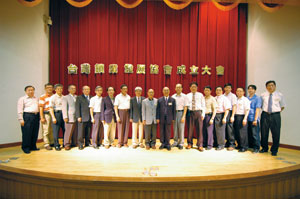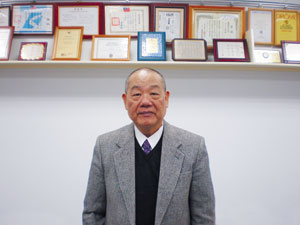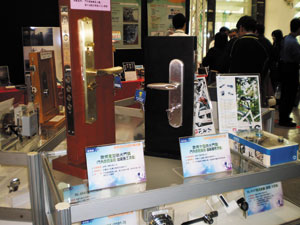LAT Locks Up Promising Future for its Members in Taiwan
Chairman Ho believes and practices OBM as c
2010/03/04 | By Steve ChuangFollowing in the footsteps of other manufacturing groups that have set up formal trade associations, and with assistance of the (Metal Industries Research & Development Centre), a non-profit R&D institute founded in 1963 in Kaohsiung to develop metallic industries, over one hundred lock manufactures, locksmiths and subcontractors in Taiwan officially set up the Locks Association of Taiwan (LAT) on June 6, 2009, setting a milestone in Taiwan's lock industry.
As the first association of its kind in Taiwan, the LAT is backed by strong support from the MIRDC and academia, such as the National Cheng Kung University, and intensely concerned by officials of the Ministry of Economic Affairs. The LAT has got off on the right foot, posting a man with invested interest in the trade as its first chairman: I.H. Ho, also the president of Real Locks & Securities Co., Ltd. founded in 1972 and renowned as a world-caliber supplier of locksets with its own “Real” brand.

As with most other exporters and manufacturers, the lock making sector in Taiwan also dates back to the1950s, when a few manufacturers in Pingtung and Chiayi cunties in southern Taiwan stamped out various locks and related components. After nearly 60 years, the sector now turns out a variety of locks to have built solid ground globally, with 80% of output exported. MIRDC-compiled figures show the industry's exports have been on an uptrend: rising from NT$8.48 billion (about US$265 million) to NT$12.77 billion (US$399 million) during the 2003-2007 span. In 2007, the U.S. bought 45% of the sector's exports and China 8.4%, the top-two overseas markets.
To help members to cope with increasingly challenging global markets, the LAT aims to work on raising competitiveness and secure sustainability by coordinating official, industrial and academic parties, Ho says.

Status Quo
Painting a picture of the pioneering days of the local lock sector before detailing LAT's development plans, Ho says that the first specialized lock maker Lung Hui Metal Mfg. Co., Ltd. was set up in 1948 in Pingtung County, southern Taiwan to mark the formal birth of the island's lock industry. More followed, with two of the largest ones now—Tong Lung Metal Industry Co. (1953) and Taiwan Fu Hsing Industrial Co., Ltd. (1957)—to help expand scale of the industry, which experienced the golden age from 1970 to 1985, driven by influx of OEM (original equipment manufacturing) orders from abroad.
“Over 300 lock and component makers exist in Taiwan. Real Locks & Securities, Tong Lung, Fu Hsing and Lung Hui all have been in business for more than 30 years as the four veterans, with Real Locks & Securities and Lung Hui also well-known globally for branded locks,” says Ho.
With decades of technical upgrades and information sharing, Ho says that the industry supplies wide-ranging locks and products, including door locks, cylinder locks, padlocks, and anti-theft locks for cars, motorcycles, furniture, and doors, among others. Also, he adds, Taiwanese suppliers can also supply locks built with advanced security technologies, such as electronic locks, IC card locks, infrared remote deadbolt locks, IRIS recognition solutions and biometric fingerprint door locks. “In fact and including components and related applications, the domestic lock industry's overall revenues can reach around NT$400 billion (US$12.5 billion) a year,” says Ho.
Makers in Taiwan mainly export door locks, padlocks of copper, alloys and stainless steel, cam locks, cabinet locks and motorcycle and bicycle locks, in low to high end varieties, to such markets as Japan, Europe, the U.S., Australia, Southeast Asia, Africa and Latin America. “Fortunately the sector wasn't battered as seriously as other industries in 2009, with exports believed not to have dropped more than 10% from 2008,” says Ho. He added that locks are in demand in industries, business and residences regardless of the global downturn in 2009, while excellent quality and competitive prices also helped the industry to weather the economic storm.
Threats
As in other manufacturing sectors, more emerging rivals are making life tough for Taiwanese lock makers. Ho says that dumping is threatening Taiwanese makers, especially ones still incapable of handling OEM or ODM (original design manufacturing) orders. Without going upmarket, they may not survive in the segment for low-end, standardized locks.
Also Taiwanese makers have to upgrade to meet increasingly higher demands and catch up with competitors in advanced countries. Taiwanese suppliers must try to invest more in R&D to enhance product quality, functionality and security to build capability, as well as trustworthiness, so buyers will fully rely on Taiwan-made locks to protect property and security, says Ho. Unfortunately the age-old problem remains: most Taiwanese lock makers simply don't have enough resources to invest in R&D.
Another potentially major downfall for the sector is counterfeiting. After all, it is far easier, cheaper to copy than invest in genuine R&D, from which results are sometimes not commercially exploitable for many years. Such unethical behavior has far-reaching impacts. Not only does copycatting ruin short-term gains for conscientious lock makers but also could discourage them from making further R&D investments. “Specifically all locks sold globally can be graded according to security characteristics; the higher the grade, the more secure and profitable the item. But some unethical makers defraud consumers with counterfeits. And some even mislabel product origins to gain higher profits and build reputation,” says Ho. Gresham's Law of “Bad money drives out the good” accurately sums up such post-crash scenario, when consumers are now more price-sensitive.
LAT Objectives
The LAT will do more than aid industry insiders to acquire R&D resources from the government, academia and MIRDC. It will also upgrade and make the sector more “secure” from fraud, including grading of locks, certification and education of makers, offering seminars on intellectual property rights, certifying product origin, and innovation assessment.
A few companies have already developed high-grade locks, such as EN12320 Grade 5 padlocks, in collaboration with the MIRDC, that were debuted at the Stars Project Achievement Presentation Dec. 7-11, 2009 in Kaohsiung. “This is the type of cross-industry cooperation our association will continue pushing,” Ho says.
The LAT will also reinforce industry-and-academia ties to take advantage of student innovation, typically a highly affordable intellectual resource. Allowing undergrads and post-grads to work on projects makes available economical, less risky R&D solutions to small operators. “Working with students on new product development allows those with limited financial resources to engage in R&D without making major investments or taking risks,” says Ho. Another side benefit is, he adds, such strategy will help traditional industries to attract young, potential employees.
Typical of industrial upgrading in Taiwan, the LAT will study related regulations and technical documents enforced in advanced countries as Japan and Europe, seek advice from experts and university professors and then set globe-caliber criteria to assure locks are strictly certified as to product origin and grade. “As such we aim to help conscientious makers reap deserved gains from R&D, minimize counterfeits and help members to better cope with reckless competition,” notes Ho, adding that the program will also help consumers to better recognize genuinely good products and contribute to industrial sustainability.
Also upgrading the locksmith trade, the LAT will ask for support from the Ministry of the Interior to set up courses and examinations to qualify locksmiths as licensed professionals. “Future locksmiths in Taiwan will be educated, tested, certified to legally run business, and above all be taught professional ethics,” Ho says. In short, the LAT aims to upgrade the value chain in the Taiwanese lock industry to maximize its development.
Go OBM
To better compete in the global market in the future, Ho repeatedly emphasizes that innovation is key for Taiwanese lock manufacturers to better handle tariff barriers in EU and ASEAN free trade areas. “I have encouraged industry insiders to pay more attention to R&D to differentiate from competitors, build capability and image among customers; because I believe being unique assures a promising future, not to be No. 1,” he says.
Ho also religiously promotes branding: his company Real Locks & Securities has been loyal to build itself as an OBM (original branding manufacturer) for decades, setting a model in the Taiwanese lock manufacturing sector. The man is fully justified—citing a report in BusinessWeek, Ho says, “World's top-100 brands earn US$228 billion in profits a year, almost 60 times the US$4 billion by the biggest-100 OEMs.”
Taiwan's lock makers have carved a respectable niche globally with skilled manufacturing and development, able to turn out blade cylinders, pin tumbler cylinders, tubular cylinders, Kaba cylinders, and disc cylinders. Also Taiwan suppliers can apply stainless steel, cold steel, cooper, alloys, zinc, and aluminum to roll out middle-to-high-end locks and customized models with high-tensile structure, high impact and corrosion resistance, dustproof and bulletproof features for special purposes, according to Ho. He continues that Taiwanese lock makers can compete globally with own-brand locks, and therefore a significant task for the LAT is to promote the importance of branding and assist insiders to evolve into OBMs.

Daunting Mission
Finally and taking on perhaps the most daunting mission, due to conflict-of-interest, Ho says that the LAT will foster cooperation between insiders as well as coordinate industrial effort. Drawing from personal experience as example, Ho says that Real Locks & Securities partnered with a peer, tapping mutual core competence, to build cylinders and lock housing that resulted in a brand new lock, which has been ordered and delivered overseas as a high-profile product. “Such strategy could enhance overall efficiency to help makers develop and produce new products to strengthen global competitiveness.”




